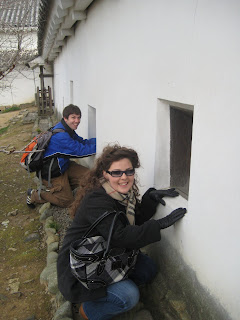
Students pray lucky charms do trick
Temples, zoos, teams tap superstitions to sell talismans to entrance examinees
Some challenges in life can only be overcome through one's own efforts. But it never hurts to have a bit of luck.
At least that's how students facing high school and university entrance examinations feel around this time of year as they prepare for tests that could set the course of their lives.
On these occasions, many entrance exam hopefuls and their families visit shrines and temples to pray and pick up a good luck charm, hoping it will help them get into the school of their choice.
But as even this may not be enough to help some overcome their enormous anxiety, some businesses have seized on the opportunity and are cashing in on the game of luck, selling products ranging from good luck snacks to animal droppings that are supposed to bring good tidings.
From early January through the end of March — entrance exam season — Meiji Seika Kaisha Ltd.'s long-selling Karl corn puff is marketed as Ukarl.
The product's name is temporarily changed because Ukarl sounds similar to the Japanese verb "ukaru," or to pass.
The package is designed to look like a good luck charm, while the snack's signature character, Uncle Karl, is transformed into a Shinto priest, praying for examinees to pass their exams.
According to Meiji Seika, the firm has been marketing Ukarl since 2001. It was a hit from the start with students and their families.
"In the past, we've received letters from consumers thanking us because they ate Ukarl and made it to the schools they were aiming for," a Meiji Seika spokesman said.
The popular, long-selling chocolate biscuit Koala no March by Lotte Co., Meiji Seika's rival, now comes with a special package in which its koala characters are turned into red and white "daruma" wish dolls.
Unlike Karl, the snack does not have any sound in its name that connotes good luck. Instead, it is the koala itself that brings the good fortune, according to the firm, noting that while koalas spend most of their time sleeping in trees, they never fall.
Exam hopefuls, too, hope to cling to the tree of victory.
It's not just Lotte that is cashing in on the trend. Several zoos nationwide also believe koalas are considered good luck, although some take it to an extreme level.
Higashiyama Zoo and Botanical Gardens in Nagoya earlier this month distributed a hand-made paper bookmark made partly from koala droppings.
While it may sound ridiculous, the droppings are actually the key ingredient because luck in Japanese is pronounced "un," which sounds similar to "unchi," or "poo" in the vocabulary of Japanese children.
Nor does it smell as bad as it sounds, because the eucalyptus fiber — extracted from the droppings and sterilized — is mixed with fiber from recycled paper.
The bookmark says: "Although koalas sleep in trees for 18 to 20 hours a day, they never fall. This (bookmark) contains the 'luck' of koalas, so it will bring good fortune. Use this bookmark as you prepare for the entrance exams. All the animals at the zoo are praying for your success."
According to Kazuhito Ito of the zoo, the bookmarks were first distributed last year for free, and stocks ran out immediately.
To meet demand, the zoo this year increased the number of bookmarks to 500 from last year's 300, but stocks still ran out on Jan. 4, when they were distributed again for free.
At Ishikawa Zoo in Ishikawa Prefecture, orangutans are believed to bring good luck. Since 2005, the zoo has been giving away pin buttons with a picture of their male orangutan, Brotos, who is good at walking on tightropes and never falls off.
"People who come to get the pins are mostly grandparents who want to send it to their grandchildren who are facing entrance exams," said Shinichi Takeda, a spokesman for Ishikawa Zoo.
J. League soccer team Omiya Ardija this month began marketing its own good luck charms.
The team believes it is lucky because it has managed to escape being relegated from Division One to Division Two for four straight years.
for four straight years.
Hoping their "perseverance" will give the examinees strength, each of the team's good luck charms contains a ticket that was prepared for a match they would have had to play if they had dropped into Division Two.
Because they were able to remain in the top division,the tickets were not used.
A total of 500 good luck charms were sold in five days after going on sale Jan. 6. Due to the high demand, the team is currently accepting orders for 1,000 more charms, according to the team spokesman.
The good luck charms, which bear the kanji "katsu" (victory), went on sale after they were prayed for at a shrine near the team headquarters in the city of Omiya, Saitama Prefecture, he said.
he said.
"It's actually not just our supporters or examinees and their parents anymore, but company employees also buy them, apparently with the hope that their companies will hold on amid the bad economy," he said.





























































